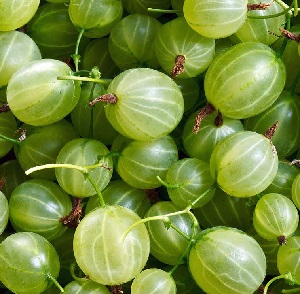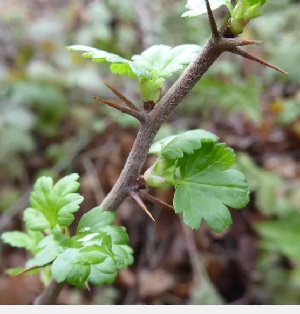
Gooseberry U-Pick Orchards or farms in Minnesota in 2025, by area of state
Keep in mind, not all areas of a state have gooseberries orchards that are open to the public. If you know of any others, please tell us using the add a farm form!
These are the areas of the state that have gooseberry orchards to pick gooseberries. Click on the area closet you!
- Central-Northwest Minnesota
- Northwestern Minnesota
- Southern Minneapolis and southern suburbs, Minnesota
gooseberries
 Gooseberry Picking Tips, Recipes and Information
Gooseberry Picking Tips, Recipes and Information
If you are about to pick Gooseberries either directly from a tree, or from a local orchard or market, here's what you need to know to pick the best Gooseberries.
Gooseberries are a fairly early crop, flowering soon after the last frosts in April and May, setting fruit in June, usually at the same time as strawberries in most areas (but check your area's harvest calendar and call the farm or orchard you are planning to go to a few weeks ahead).
Gooseberry picking tips
Here are tips and instructions on how to pick Gooseberries:
What type
See this page for gooseberry varieties.
When
- Timing is Key: Gooseberries are typically ready for picking in the summer, usually from June to July, depending on the variety and your location.
- Always check with the farm before you go; conditions can change dramatically from day to day.
Preparation
- Use Clean Hands: Make sure your hands are clean before you start picking to avoid transferring dirt or contaminants to the berries.
- Bring Containers: Use shallow containers, baskets, or colanders to collect the berries. This prevents them from being crushed under their own weight. .
How to Choose and Pick Gooseberries
- Look for Color and Size: Choose gooseberries that are fully ripe and have reached their full color. The color varies depending on the variety and can range from green to red or even purple. See this page for description sof each of the varieties of gooseberries.
- Test for Ripeness: Gently squeeze the gooseberries. Ripe ones should be slightly soft to the touch but not mushy. They should give a little when pressed.
- Be Gentle with Berries: Gooseberries are delicate and can bruise easily. Handle them with care to maintain their quality.
- Avoid Underripe Berries: Leave berries that are hard and unyielding on the bush, as they are not yet ripe.
- Check the Softness: Be cautious of berries that are overly soft, as they might be overripe and prone to bruising.
- Mind the Thorns: Gooseberry bushes can have thorns, so wear gloves and long sleeves to protect your hands and arms while picking.
- Use Gentle Pressure: Hold the gooseberry gently between your thumb and forefinger, and twist it slightly to detach it from the stem.
- Harvest Clusters: Gooseberries often grow in clusters. You can pick entire clusters by gently holding the branch and detaching the whole group at once.
- Inspect for Pests: While picking, keep an eye out for any pests that might be hiding in the foliage or on the berries.
- Avoid Removing Leaves: Try to avoid pulling off leaves or damaging the bush while picking. Leaves provide energy to the plant.
After Harvesting
- Cool: Get them into the shade as soon as possible.
- Separate Unripe and Ripe Berries: As you pick, separate underripe berries from ripe ones to ensure even ripening and better quality.
- Store Properly: After picking, gently transfer the gooseberries into shallow containers or bags. Store them in the refrigerator as
soon as possible to maintain freshness.
- *
Before you leave to go to the farm:
- Always call before you go to the farm - Gooseberries are affected by weather (especially rain and cooler temperatures) more than most crops. And when they are in season, a large turnout can pick a field clean before noon, so CALL first! Always call before you go to the farm - Gooseberries are affected by weather (especially rain and cooler temperatures) more than most crops. And when they are in season, a large turnout can pick a field clean before noon, so CALL first!
 Leave
early. On weekends, then fields may be picked clean by NOON!
Leave
early. On weekends, then fields may be picked clean by NOON!
- Most growers furnish picking containers designed for Gooseberries, but they
may charge you for them; be sure to call before you go to see if you need to
bring
containers.
If you use your own containers, remember that heaping Gooseberries more than 3 inches deep will smush the lower Gooseberries. Plastic dishpans, metal oven pans with 3 inch tall sides and large pots make good containers. I like the Glad storage containers like the one at right. - Bring something to drink and a few snacks; you'd be surprised how you can work up a thirst and appetite! And don't forget hats and sunscreen for the sun. Bugs usually aren't a problem, but some deet might be good to bring along if it has been rainy.
When you get home
- DON'T wash the Gooseberries until you are ready to use them. Washing makes them more prone to spoiling.
- Keep them cool: Temperatures between 34 F and 38 F are best, but, be careful not to freeze Gooseberries! (Fresh Gooseberries are highly prone to freeze damage).
- Sort again: Pour them out into shallow pans and remove any mushed, soft or rotting Gooseberries
- Freeze: Gooseberries can also be frozen for longer storage.
- Use Quickly: Gooseberries have a relatively short shelf life. Plan to use or preserve them within a few days of picking.
- Consider Usage: Gooseberries can be used in both sweet and savory dishes, such as jams, pies, sauces, and even pickles
- Use or freeze quickly: Even under ideal conditions Gooseberries will only keep for a week or two in a refrigerator, so for best flavor and texture, consume or freeze them as soon as possible after purchase.
- See my How to freeze berries page. (Unless you're going to make jam right away)
- Now, get ready to make Gooseberries jam - It is VERY easy
Gooseberries Recipes, Canning, Jam, Jelly, and related resources
Other Local Farm Products (Honey, Horses, Milk, Meat, Eggs, Etc.)
(NOT pick-your-own, unless they are also listed above)
- Farm markets and roadside stands
- Local Honey Finder
- Local Meat, Milk and Eggs
- Venues: Farms, Wineries, Orchards for your event, wedding or party
- Easter egg hunts
- Children"s consignment sales
- Fruit and vegetable festivals
- Winery tours and wine tastings
- Horse rides, stables, lessons, trails
- Maple Syrup farms and sugarworks
- Bed & Breakfasts on Farms, Wineries, Ranches and Orchards
- Pumpkin patches
- Corn mazes
- Zombie Paintball venues
- Christmas Tree Farms & lots
- Environmental resources
- Consumer fraud information
- Wholesale food sources
- Resources for Farmers
Looking for canning equipment and supplies?
Water bath canner with a jar rack
Pressure canners for gas, electric and induction stoves: Presto 23Qt or T-fal 22Qt
Canning scoop (this one is PERFECT)
Ball Blue book (most recent version)
Jars: 8oz canning jars for jams
Find Other types of farms:
Farm markets and roadside stands
Road trips and camping resources
Local Honey, apiaries, beekeepers
Consumer fraud and scams information
Home canning supplies at the best prices on the internet!
Maple Syrup Farms, sugarworks, maple syrup festivals
Environmental information and resources
Farms For Your Event for birthday parties, weddings, receptions, business meetings, retreats, etc.
Festivals - local fruit and vegetable festivals
Get the
most recent version of
the Ball Blue Book
With this Presto 23 quart pressure canner and pressure cooker, you can "can" everything, fruits, vegetables, jams, jellies, salsa, applesauce, pickles, even meats, soups, stews. Model 01781

You can make jams, jellies, can fruit, applesauce, salsa and pickles with water bath canners, like this Granite Ware 12-Piece Canner Kit, Jar Rack, Blancher, Colander and 5 piece Canning Tool Set

